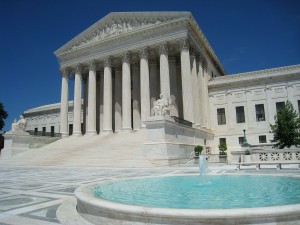Why Choose Federal Appeal Lawyers: Proven Approaches for Effective Appeals
Why Choose Federal Appeal Lawyers: Proven Approaches for Effective Appeals
Blog Article
Debunking the Process of Federal Appeals: What You Need to Know
Navigating the complex world of federal appeals can typically appear like going across uncharted waters for those unfamiliar with the procedure. Understanding the nuances of appellate court jurisdiction, the ins and outs of submitting a notification of allure, offering an engaging brief, and making a persuasive oral argument are important elements that can considerably affect the result of a situation. By unwinding the layers of intricacy bordering federal charms, individuals can acquire a clearer insight into the mechanisms that govern this vital stage of the legal system.
Understanding Federal Appeals Process
Looking into the detailed world of the government charms process unveils a structured and systematic journey through the judicial system. Federal allures work as a vital system for examining decisions made by lower courts. Recognizing this procedure is necessary for any individual associated with lawful procedures at the federal degree.
The process usually begins with an event disappointed with a lower court's judgment submitting a notice of allure. This activates an evaluation by a higher court, where a panel of courts examines the legal debates provided by both celebrations. Briefs outlining the lawful reasoning behind each event's setting are sent, and dental debates might be heard to clear up intricate problems.
The appellate court's decision is based on a detailed assessment of the reduced court's procedures and the disagreements provided. When the appellate court reaches a decision, it can affirm, reverse, remand, or change the reduced court's judgment, offering clarity and finality to the legal disagreement.
Appellate Court Territory Discussed
As we advance from understanding the government allures process to dissecting the complexities of appellate court jurisdiction, a basic element comes to light pertaining to the authority and restrictions of these higher courts in the lawful landscape. Appellate court territory refers to the extent of situations that a particular appellate court has the power to determine and evaluate upon. Unlike high court that listen to cases for the very first time, appellate courts are restricted to reviewing choices made by lower courts. These decisions can include judgments from both state and government courts.
Appellate courts have jurisdiction over specific sorts of situations, typically those including legal errors, step-by-step issues, or concerns of law as opposed to valid disputes. The territory of appellate courts is usually described in laws and laws that regulate the court system. Comprehending appellate court jurisdiction is vital for celebrations associated with the appeals procedure as it figures out whether an instance is eligible for evaluation and the level to which the appellate court can intervene in the lower court's choice.
Declaring a Notice of Charm
The first action in commencing the federal charms procedure entails submitting a Notice of Appeal with the proper appellate court. This critical paper formally notifies the court and the other parties included in the situation that the appealing event plans to look for a review of the lower court's decision. Filing a Notice of Appeal is a strict step-by-step need that establishes the appellate process in motion.
When preparing the Notice of Appeal, it is vital to make sure conformity with the certain regulations and standards of the pertinent appellate court. federal appeal lawyers. The document must generally consist of details such as the instance name, the reduced court's name, the day of the judgment being appealed, and a concise statement indicating the grounds for the allure

Instruction and Oral Disagreement
In the appellate process, presenting composed briefs and engaging in oral debates play critical duties in promoting for the appealing event's placement prior to the appellate court. Briefs are extensive lawful documents that detail the parties' disagreements, legal authorities, and analysis sustaining their positions. These created submissions supply the court with a detailed understanding of the truths of the instance, the relevant legislation, and why the appealing event believes the lower court's decision need to be rescinded.
Following the submission and review of the briefs, oral debates offer the parties an opportunity to additional clarify their positions, address any kind of inquiries the appellate judges may have, and emphasize crucial points from their created briefs. Dental disagreements are a chance for the attorneys to convince the courts with spoken advocacy and responses to inquiries from the bench.
Both the written briefs and dental arguments are important elements of the appellate procedure, allowing celebrations to provide their situation completely and compellingly before the appellate court. - federal crime lawyer
Obtaining the Appellate Court Decision
Upon completion of dental disagreements and entry of written briefs, the next essential stage in the appellate procedure involves waiting for the decisive judgment from the appellate court. This period of anticipation can be loaded with a mix of anxiety and hope for events included in the charm. The appellate court's choice is typically provided in a created format and outlines the court's verdicts on the legal issues presented, the thinking behind their decision, and the judgment provided. The time frame for getting the appellate court's choice can vary, but courts strive to give prompt resolutions. Once the choice is provided, parties should carefully assess the court's judgment to understand the result and figure out any type of more steps that might be required. Whether the appellate court verifies, reverses, or remands the reduced court's choice, comprehending the effects of the ruling is crucial for all parties involved in the appellate process. Quickly examining and understanding the appellate court's decision is necessary in navigating the following actions in the lawful proceedings.
Final Thought
Understanding the appellate court jurisdiction, filing a notice of charm, preparing briefs, and presenting oral arguments are all crucial components of this process. Inevitably, receiving the appellate court decision can supply clearness and resolution to lawful disagreements.
As we advance from comprehending the federal appeals process to studying the details of appellate court territory, a basic aspect comes to light regarding the authority and restrictions of these greater courts in the legal landscape. Appellate court territory refers to the range of instances that a particular appellate court has the power to examine and determine upon. Unlike trial courts that hear instances for the first time, appellate courts are restricted to examining choices made by reduced courts. Understanding appellate court jurisdiction is crucial for celebrations included in the allures process as it establishes whether a case is eligible for evaluation and the level to which the appellate court can interfere in the lower court's choice.

Report this page